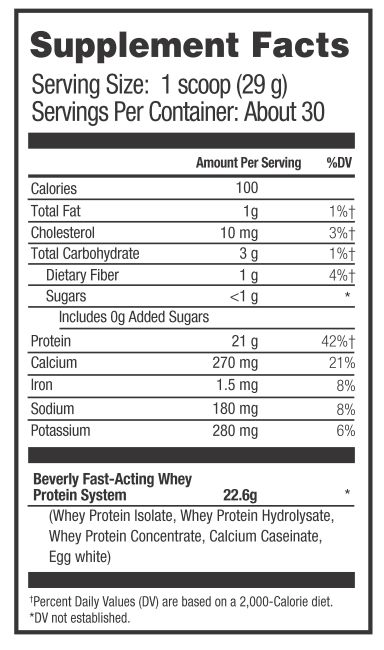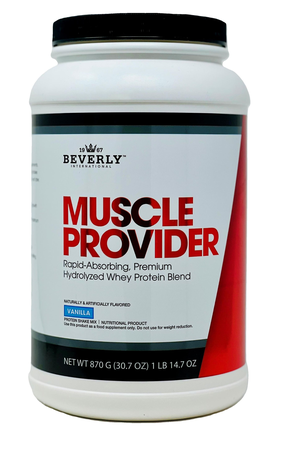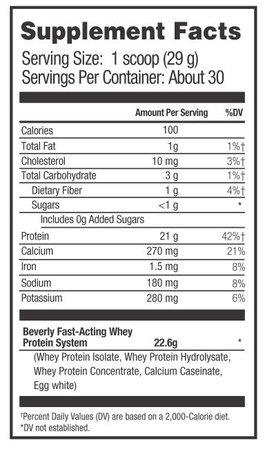Beverly International Muscle Provider Chocolate - 1 Lb 14.7 Oz Item #: BV015UPC: 857254000290
$53.74 $40.31
25% Off Special Offer
In stock
freeShipping: 0
Add to Cart
Unleash Your Muscle Growth Potential! Muscle Provider is a top-tier protein supplement designed to maximize muscle gains with a blend of high-quality proteins from milk and egg, including whey protein isolate and hydrolysate. It provides 21 grams of protein per serving, with almost no lactose, and zero sugar. The formula, developed by Beverly International's founder Jim Heflin, offers unparalleled taste and quick absorption, making it ideal for muscle growth and strength. It meets stringent manufacturing standards and includes no banned substances.
A high-speed whey unlike any other.
Muscle Provider is the pinnacle of no-nonsense whey protein supplements. Its exceptionally high level of WPH allows it to produce lighter, non-filling shakes that feed your tired muscles lightning fast without leaving you too full to eat later.
Benefits
Why people like it
Exceptionally high in whey protein hydrolysate (WPH) and isolate (WPI). WPH is cross-flow filtered and enzymatically hydrolyzed to produce a mixture of peptides and free form amino acids that is ready for rapid uptake.
How do I choose between Muscle Provider and other Beverly proteins?
Choose Muscle Provider if you mainly want to use it:
immediately pre- and/or post-workout,
Secrets to Success
Ironclad Guarantee: With two terrific flavors to choose from, (vanilla and chocolate) and backed by our 100% satisfaction guarantee, you just can't lose with Muscle Provider. Order today and join the ranks of other champions who've made Muscle Provider their protein of choice! Muscle Provider is backed by our 60-Day, Zero-Risk, 100% Satisfaction Guarantee.
More items you might like
Beverly International Muscle Provider Chocolate - 1 Lb 14.7 Oz Q&A What makes Muscle Provider different from other protein supplements? Muscle Provider includes the highest quantities of high-quality proteins like whey protein isolate and hydrolysate, offering superior taste, absorption, and muscle-building potential.
How does Muscle Provider taste? Many consumers rate it as the most delicious protein supplement available, with chocolate tasting like fresh cupcake batter and vanilla similar to soft-serve ice cream.
Why should I choose Muscle Provider? It is a top-tier protein powder designed for rapid absorption and maximum anabolic potential, utilizing premium ingredients that enhance muscle growth and strength.
Can I take Muscle Provider if I have dietary restrictions? Yes, it is very low in lactose, sugar, and fat, making it suitable for those with lactose intolerance or those looking for a low-sugar protein option.
Is Muscle Provider safe to take daily? Yes, Muscle Provider can be used daily as a protein supplement. However, consulting with a medical doctor before beginning any new supplement is always advisable.
How should I use Muscle Provider for best results? For optimal results, consume Muscle Provider first thing in the morning, before training, and after workouts. Mix with water and take on an empty stomach.
Does Muscle Provider contain any banned substances? No, Muscle Provider is produced in a lab that complies with GMP and GMP for Sport programs, ensuring it contains no banned substances.
Why does Muscle Provider contain multiple types of proteins? The blend of different proteins provides a superior amino acid profile, enhancing digestion, absorption, and muscle-building effects, while also improving taste and texture.
How long has Muscle Provider been in the market? Muscle Provider has been a leading designer protein supplement since its creation in 1995 by Jim Heflin and has remained a benchmark in the industry.
What are the main benefits of using Muscle Provider? Muscle Provider supports muscle growth and strength, enhances protein synthesis, reduces muscle breakdown, and provides a delicious, easy-to-mix, and low-sugar protein supplement.
Copyright 2019 - 2025 DPS Nutrition
[{"u":"\/b\/466\/5-nutrition.htm","n":"5% Nutrition"},{"u":"\/b\/486069\/abe-nation.htm","n":"ABE Nation"},{"u":"\/b\/411\/allmax-nutrition.htm","n":"AllMax Nutrition"},{"u":"\/b\/446\/alpha-gainz.htm","n":"Alpha Gainz"},{"u":"\/b\/486023\/alpha-lion.htm","n":"Alpha Lion"},{"u":"\/b\/486053\/anabar.htm","n":"Anabar"},{"u":"\/b\/486094\/anarchy-labs.htm","n":"Anarchy Labs"},{"u":"\/b\/188\/animal-products.htm","n":"ANIMAL Pak"},{"u":"\/b\/9\/ansi.htm","n":"ANSI Nutrition"},{"u":"\/b\/461\/apollon-nutrition.htm","n":"Apollon Nutrition"},{"u":"\/b\/486007\/axe-sledge.htm","n":"Axe & Sledge"},{"u":"\/b\/486037\/axis-labs.htm","n":"Axis Labs"},{"u":"\/b\/486060\/bang-energy.htm","n":"Bang Energy"},{"u":"\/b\/486031\/barebells-protein-bars.htm","n":"Barebells Protein Bars"},{"u":"\/b\/486084\/beast-bites-creatine-gummies.htm","n":"Beast Bites Creatine Gummies"},{"u":"\/b\/15\/beverly-international.htm","n":"Beverly International"},{"u":"\/b\/486107\/beyond-raw.htm","n":"Beyond Raw Creatine"},{"u":"\/b\/449\/black-magic-supply-co..htm","n":"Black Magic Supply Co."},{"u":"\/b\/391\/blackstone-labs.htm","n":"Blackstone Labs"},{"u":"\/b\/486009\/body-fortress.htm","n":"Body Fortress\u00a0"},{"u":"\/b\/17\/bsn.htm","n":"BSN"},{"u":"\/b\/470\/bucked-up.htm","n":"Bucked Up"},{"u":"\/b\/474\/built-bar.htm","n":"Built Bars"},{"u":"\/b\/486047\/cbum.htm","n":"CBUM"},{"u":"\/b\/296\/cellucor.htm","n":"Cellucor"},{"u":"\/b\/457\/chemix.htm","n":"Chemix"},{"u":"\/b\/486019\/chike-nutrition.htm","n":"Chike Nutrition"},{"u":"\/b\/155\/competitive-edge-labs.htm","n":"Competitive Edge Labs CEL"},{"u":"\/b\/214\/con-cret.htm","n":"CON-CR\u0112T Creatine"},{"u":"\/b\/486064\/condemned-labz.htm","n":"Condemned Labz"},{"u":"\/b\/21\/controlled-labs.htm","n":"Controlled Labs"},{"u":"\/b\/312\/convenient-nutrition.htm","n":"Convenient Nutrition"},{"u":"\/b\/142\/core-nutritionals.htm","n":"Core Nutritionals"},{"u":"\/b\/486106\/crisp-power-protein-pretzels.htm","n":"Crisp Power Protein Pretzels"},{"u":"\/b\/486102\/david-protein-bars.htm","n":"David Protein Bars"},{"u":"\/b\/486099\/doublewood-supplements.htm","n":"Double Wood Supplements"},{"u":"\/b\/30\/dps-nutrition.htm","n":"Dps Nutrition"},{"u":"\/b\/32\/dymatize.htm","n":"Dymatize"},{"u":"\/b\/33\/eas.htm","n":"EAS"},{"u":"\/b\/34\/eclipse.htm","n":"Eclipse Sports Supplements"},{"u":"\/b\/194\/efx-sports.htm","n":"EFX Sports"},{"u":"\/b\/486113\/elev8-creamy-rice.htm","n":"Elev8 Foods Creamy Rice"},{"u":"\/b\/486093\/enhanced-labs.htm","n":"Enhanced Labs"},{"u":"\/b\/408\/epg.htm","n":"EPG Extreme Products"},{"u":"\/b\/322\/evomuse.htm","n":"EvoMuse"},{"u":"\/b\/486048\/fit-butters.htm","n":"Fit Butters"},{"u":"\/b\/412\/fit-crunch.htm","n":"Fit Crunch Bars"},{"u":"\/b\/486098\/fresh-supps.htm","n":"Fresh Supps"},{"u":"\/b\/41\/gaspari-nutrition.htm","n":"Gaspari Nutrition"},{"u":"\/b\/43\/gat.htm","n":"GAT Sport"},{"u":"\/b\/464\/g-code-nutrition.htm","n":"GCode Nutrition"},{"u":"\/b\/44\/gift-certificates.htm","n":"Gift Certificates"},{"u":"\/b\/486080\/gorilla-mind.htm","n":"Gorilla Mind"},{"u":"\/b\/486111\/grass-fed-whey-protein.htm","n":"Grass Fed Whey Protein"},{"u":"\/b\/486104\/hangryboy-snacks.htm","n":"Hangryboy Snacks"},{"u":"\/b\/343\/hardrock-supplements.htm","n":"HardRock Supplements"},{"u":"\/b\/46\/hi-tech-pharmaceuticals.htm","n":"Hi-Tech Pharmaceuticals"},{"u":"\/b\/486096\/hosstile.htm","n":"Hosstile"},{"u":"\/b\/486112\/htlt.htm","n":"HTLT"},{"u":"\/b\/486105\/humann-superbeets.htm","n":"HumanN SuperBeets"},{"u":"\/b\/434\/dermacrine-topical.htm","n":"Iconic Formulations"},{"u":"\/b\/447\/iron-legion.htm","n":"Iron Legion"},{"u":"\/b\/415\/isopure.htm","n":"Isopure"},{"u":"\/b\/486045\/jnx-sports.htm","n":"JNX Sports"},{"u":"\/b\/486074\/jocko-fuel.htm","n":"Jocko Fuel"},{"u":"\/b\/486089\/killer-labz.htm","n":"Killer Labz"},{"u":"\/b\/56\/labrada.htm","n":"Labrada Nutrition"},{"u":"\/b\/483\/legendary-foods.htm","n":"Legendary Foods"},{"u":"\/b\/379\/lenny-larrys-cookies.htm","n":"Lenny & Larry's Cookies"},{"u":"\/b\/486110\/levels.htm","n":"Levels"},{"u":"\/b\/486067\/life-extension.htm","n":"Life Extension"},{"u":"\/b\/486090\/magnum-nutraceuticals.htm","n":"Magnum Nutraceuticals"},{"u":"\/b\/58\/man-sports.htm","n":"Man Sports"},{"u":"\/b\/486095\/mesomorph.htm","n":"Mesomorph"},{"u":"\/b\/59\/met-rx.htm","n":"Met-Rx"},{"u":"\/b\/286\/metabolic-nutrition.htm","n":"Metabolic Nutrition"},{"u":"\/b\/60\/mhp.htm","n":"MHP"},{"u":"\/b\/61\/molecular-nutrition.htm","n":"Molecular Nutrition"},{"u":"\/b\/385\/muscle-addiction.htm","n":"Muscle Addiction"},{"u":"\/b\/486054\/muscle-milk.htm","n":"Muscle Milk"},{"u":"\/b\/64\/muscle-sandwich.htm","n":"Muscle Sandwich"},{"u":"\/b\/277\/musclemeds.htm","n":"MuscleMeds"},{"u":"\/b\/66\/muscletech.htm","n":"MuscleTech"},{"u":"\/b\/417\/mutant.htm","n":"Mutant"},{"u":"\/b\/486003\/myogenix.htm","n":"Myogenix"},{"u":"\/b\/486108\/myprotein.htm","n":"Myprotein Protein Wafer"},{"u":"\/b\/68\/natures-best.htm","n":"Natures Best"},{"u":"\/b\/72\/now-foods.htm","n":"Now Foods"},{"u":"\/b\/371\/nutrakey.htm","n":"Nutrakey"},{"u":"\/b\/486100\/nutraphase.htm","n":"Nutraphase"},{"u":"\/b\/486088\/nutrex.htm","n":"Nutrex"},{"u":"\/b\/348\/nuts-n-more.htm","n":"Nuts 'n More"},{"u":"\/b\/486034\/ohana-liquid-protein.htm","n":"Ohana Liquid Protein"},{"u":"\/b\/442\/one-bars.htm","n":"ONE Bars"},{"u":"\/b\/486097\/one-of-one.htm","n":"One of One"},{"u":"\/b\/77\/optimum-nutrition.htm","n":"Optimum Nutrition - ON"},{"u":"\/b\/78\/ostrim.htm","n":"Ostrim"},{"u":"\/b\/486091\/oxyshred.htm","n":"OxyShred"},{"u":"\/b\/486066\/panda-supps.htm","n":"Panda Supps"},{"u":"\/b\/398\/performax-labs.htm","n":"Performax Labs"},{"u":"\/b\/127\/power-crunch-bars.htm","n":"Power Crunch Bars"},{"u":"\/b\/486083\/premier-protein.htm","n":"Premier Protein"},{"u":"\/b\/486027\/ap-sports-regimen.htm","n":"Prime Bites"},{"u":"\/b\/486050\/professor-nutz-peanut-butter.htm","n":"Professor Nutz Peanut Butter"},{"u":"\/b\/486033\/project-ad.htm","n":"Project AD"},{"u":"\/b\/435\/psycho-pharma.htm","n":"Psycho Pharma"},{"u":"\/b\/486085\/pump-sauce.htm","n":"Pump Sauce"},{"u":"\/b\/331\/pure-protein.htm","n":"Pure Protein"},{"u":"\/b\/220\/purus-labs.htm","n":"Purus Labs"},{"u":"\/b\/260\/quest-bar.htm","n":"Quest Nutrition"},{"u":"\/b\/486008\/raw-nutrition.htm","n":"Raw Nutrition"},{"u":"\/b\/486092\/raze-energy.htm","n":"Raze Energy"},{"u":"\/b\/418\/redcon1.htm","n":"RedCon1"},{"u":"\/b\/486086\/redefine-foods.htm","n":"Redefine Foods"},{"u":"\/b\/486061\/redline.htm","n":"Redline"},{"u":"\/b\/486013\/repp-sports.htm","n":"Repp Sports"},{"u":"\/b\/486012\/revive-md.htm","n":"Revive"},{"u":"\/b\/486065\/rule-1.htm","n":"Rule 1"},{"u":"\/b\/452\/ryse-supplements.htm","n":"RYSE"},{"u":"\/b\/91\/serious-nutrition-solutions.htm","n":"SNS Serious Nutrition Solutions"},{"u":"\/b\/210\/species-nutrition.htm","n":"Species Nutrition"},{"u":"\/b\/486103\/spoken-nutrition.htm","n":"Spoken Nutrition"},{"u":"\/b\/486109\/think-protein-bars.htm","n":"Think Protein Bars"},{"u":"\/b\/486035\/train-naked-labs.htm","n":"Train Naked Labs"},{"u":"\/b\/108\/ultimate-nutrition.htm","n":"Ultimate Nutrition"},{"u":"\/b\/109\/universal-nutrition.htm","n":"Universal Nutrition"},{"u":"\/b\/486101\/unmatched-nutrition.htm","n":"Unmatched Nutrition"},{"u":"\/b\/130\/usp-labs.htm","n":"Usp Labs"},{"u":"\/b\/216\/vigor-labs.htm","n":"Vigor Labs"},{"u":"\/b\/486114\/vital-proteins-collagen.htm","n":"Vital Proteins Collagen"},{"u":"\/b\/370\/vmi-sports.htm","n":"VMI Sports"},{"u":"\/b\/463\/xtreme-performance-gels.htm","n":"XPG Xtreme Performance Gels"},{"u":"\/b\/137\/scivation.htm","n":"Xtend"}]
[[{"id":1557,"u":"\/d\/1557\/5-htp.htm","n":"5-HTP"},{"id":1795,"u":"\/d\/1795\/akg-alpha-ketoglutarate.htm","n":"AAKG"},{"id":1558,"u":"\/d\/1558\/7-keto.htm","n":"7-Keto"},{"id":1560,"u":"\/d\/1560\/accessories.htm","n":"Accessories"},{"id":1561,"u":"\/d\/1561\/acetyl-l-carnitine.htm","n":"Acetyl-L-Carnitine"},{"id":1937,"u":"\/d\/1937\/adrenal-care.htm","n":"Adrenal Care"},{"id":1765,"u":"\/d\/1765\/agmatine.htm","n":"Agmatine"},{"id":2161,"u":"\/d\/2161\/akkermansia.htm","n":"Akkermansia"},{"id":1830,"u":"\/d\/1830\/almond-butter.htm","n":"Almond Butter"},{"id":1932,"u":"\/d\/1932\/almonds.htm","n":"Almonds"},{"id":2104,"u":"\/d\/2104\/aloe-vera.htm","n":"Aloe Vera"},{"id":1832,"u":"\/d\/1832\/alpha-gpc.htm","n":"Alpha GPC"},{"id":1562,"u":"\/d\/1562\/alpha-lipoic-acid.htm","n":"Alpha-Lipoic Acid"},{"id":2041,"u":"\/d\/2041\/amentoflavone.htm","n":"Amentoflavone"},{"id":1563,"u":"\/d\/1563\/amino-acids.htm","n":"Amino Acids"},{"id":2126,"u":"\/d\/2126\/anacyclus-pyrethrum.htm","n":"Anacyclus Pyrethrum"},{"id":2030,"u":"\/d\/2030\/andrographis.htm","n":"Andrographis"},{"id":1564,"u":"\/d\/1564\/antioxidants.htm","n":"Antioxidants"},{"id":1962,"u":"\/d\/1962\/anxiety-support.htm","n":"Anxiety Support"},{"id":2075,"u":"\/d\/2075\/apigenin.htm","n":"Apigenin"},{"id":2155,"u":"\/d\/2155\/apparel.htm","n":"Apparel"},{"id":1951,"u":"\/d\/1951\/appetite-control.htm","n":"Appetite Control"},{"id":1913,"u":"\/d\/1913\/apple-cider-vinegar.htm","n":"Apple Cider Vinegar"},{"id":1800,"u":"\/d\/1800\/arachidonic-acid.htm","n":"Arachidonic Acid"},{"id":1567,"u":"\/d\/1567\/arginine-ethyl-ester.htm","n":"Arginine"},{"id":2007,"u":"\/d\/2007\/arjuna.htm","n":"Arjuna"},{"id":2096,"u":"\/d\/2096\/arjunapure.htm","n":"ArjunaPure"},{"id":1868,"u":"\/d\/1868\/ashwagandha.htm","n":"Ashwagandha"},{"id":1568,"u":"\/d\/1568\/astaxanthin.htm","n":"Astaxanthin"},{"id":1970,"u":"\/d\/1970\/astragalus.htm","n":"Astragalus"},{"id":1957,"u":"\/d\/1957\/bacopa-extract.htm","n":"Bacopa Extract"},{"id":2125,"u":"\/d\/2125\/banaba-leaf-extract.htm","n":"Banaba Leaf Extract"},{"id":1998,"u":"\/d\/1998\/bar-deals.htm","n":"Bar Deals"},{"id":1569,"u":"\/d\/1569\/bars.htm","n":"Bars"},{"id":2048,"u":"\/d\/2048\/bbq-sauce.htm","n":"BBQ Sauce"},{"id":1570,"u":"\/d\/1570\/bcaa-recovery-aminos-branch-chained-amino-acids.htm","n":"BCAA"},{"id":1825,"u":"\/d\/1825\/bee-pollen.htm","n":"Bee Pollen"},{"id":2103,"u":"\/d\/2103\/beef-liver.htm","n":"Beef Liver"},{"id":1851,"u":"\/d\/1851\/beef-protein.htm","n":"Beef Protein"},{"id":1955,"u":"\/d\/1955\/beet-root.htm","n":"Beet Root"},{"id":2136,"u":"\/d\/2136\/benfotiamine.htm","n":"Benfotiamine"},{"id":1952,"u":"\/d\/1952\/berberine.htm","n":"Berberine"},{"id":1999,"u":"\/d\/1999\/bergamot.htm","n":"Bergamot"},{"id":1572,"u":"\/d\/1572\/beta-alanine.htm","n":"Beta-Alanine"},{"id":2151,"u":"\/d\/2151\/beta-hydroxybutyrate.htm","n":"Beta-hydroxybutyrate"},{"id":1995,"u":"\/d\/1995\/beta-sitosterol.htm","n":"Beta-Sitosterol"},{"id":1976,"u":"\/d\/1976\/betaine-hcl.htm","n":"Betaine"},{"id":1912,"u":"\/d\/1912\/biotin.htm","n":"Biotin"},{"id":2137,"u":"\/d\/2137\/black-cumin-seed-oil.htm","n":"Black Cumin Seed Oil"},{"id":2033,"u":"\/d\/2033\/blood-pressure.htm","n":"Blood Pressure"},{"id":1760,"u":"\/d\/1760\/blowout-products.htm","n":"Blowouts & Overstocks"},{"id":2008,"u":"\/d\/2008\/bone-broth.htm","n":"Bone Broth"},{"id":2001,"u":"\/d\/2001\/borage-oil.htm","n":"Borage Oil"},{"id":1577,"u":"\/d\/1577\/boron.htm","n":"Boron"},{"id":2093,"u":"\/d\/2093\/boswella.htm","n":"Boswella"},{"id":2060,"u":"\/d\/2060\/25-35-off.htm","n":"25-35% OFF"},{"id":1808,"u":"\/d\/1808\/bromelain.htm","n":"Bromelain"},{"id":2042,"u":"\/d\/2042\/brownie-bars.htm","n":"Brownies"},{"id":1816,"u":"\/d\/1816\/bulbine-natalensis.htm","n":"Bulbine Natalensis"},{"id":1578,"u":"\/d\/1578\/caffeine-energy-preworkout-stay-alert-capsules.htm","n":"Caffeine"},{"id":1579,"u":"\/d\/1579\/calcium.htm","n":"Calcium"},{"id":1872,"u":"\/d\/1872\/calcium-d-glucarate.htm","n":"Calcium D-Glucarate"},{"id":2132,"u":"\/d\/2132\/caloriburn-gp.htm","n":"CaloriBurn"},{"id":1580,"u":"\/d\/1580\/carb-products.htm","n":"Carbohydrate Products"},{"id":2159,"u":"\/d\/2159\/carnitine.htm","n":"Carnitine"},{"id":2102,"u":"\/d\/2102\/carnivor.htm","n":"Carnivor"},{"id":1581,"u":"\/d\/1581\/casein.htm","n":"Casein Protein"},{"id":2134,"u":"\/d\/2134\/cashew-butter.htm","n":"Cashew Butter"},{"id":2029,"u":"\/d\/2029\/cats-claw.htm","n":"Cat's Claw"},{"id":1956,"u":"\/d\/1956\/cereal.htm","n":"Cereal"},{"id":1997,"u":"\/d\/1997\/chips.htm","n":"Chips"},{"id":2064,"u":"\/d\/2064\/chlorella.htm","n":"Chlorella"},{"id":2062,"u":"\/d\/2062\/chlorophyll.htm","n":"Chlorophyll"},{"id":1783,"u":"\/d\/1783\/cholesterol-support.htm","n":"Cholesterol Support"},{"id":1831,"u":"\/d\/1831\/choline.htm","n":"Choline"},{"id":1584,"u":"\/d\/1584\/chondroitin.htm","n":"Chondroitin"},{"id":1585,"u":"\/d\/1585\/chromium.htm","n":"Chromium"},{"id":1772,"u":"\/d\/1772\/cinnamon.htm","n":"Cinnamon"},{"id":1588,"u":"\/d\/1588\/cissus.htm","n":"Cissus"},{"id":2098,"u":"\/d\/2098\/cistanche.htm","n":"Cistanche"},{"id":1589,"u":"\/d\/1589\/citrulline.htm","n":"Citrulline"},{"id":2043,"u":"\/d\/2043\/citrus-bergamot.htm","n":"Citrus Bergamot"},{"id":1590,"u":"\/d\/1590\/cla.htm","n":"CLA"},{"id":2114,"u":"\/d\/2114\/cleanse.htm","n":"Cleanse"},{"id":1591,"u":"\/d\/1591\/clothing.htm","n":"Clothing"},{"id":2071,"u":"\/d\/2071\/cocoabuterol.htm","n":"Cocoabuterol"},{"id":1920,"u":"\/d\/1920\/coffee.htm","n":"Coffee"},{"id":1938,"u":"\/d\/1938\/collagen.htm","n":"Collagen"},{"id":1864,"u":"\/d\/1864\/colostrum.htm","n":"Colostrum"},{"id":1846,"u":"\/d\/1846\/cookies.htm","n":"Cookies"},{"id":2028,"u":"\/d\/2028\/copper.htm","n":"Copper"},{"id":1593,"u":"\/d\/1593\/coenzyme-q10.htm","n":"CoQ10 Coenzyme Q10"},{"id":2149,"u":"\/d\/2149\/cordyceps.htm","n":"Cordyceps"},{"id":1996,"u":"\/d\/1996\/cortisol-support.htm","n":"Cortisol Support"},{"id":2162,"u":"\/d\/2162\/cream-of-rice.htm","n":"Cream Of Rice"},{"id":1597,"u":"\/d\/1597\/creatine.htm","n":"Creatine"},{"id":1596,"u":"\/d\/1596\/creatine-hcl.htm","n":"Creatine HCl"},{"id":2073,"u":"\/d\/2073\/creatine-specials.htm","n":"Creatine Specials"},{"id":1759,"u":"\/d\/1759\/curcumin.htm","n":"Curcumin"},{"id":1941,"u":"\/d\/1941\/cycle-support.htm","n":"Cycle Support"},{"id":1758,"u":"\/d\/1758\/d-aspartic-acid.htm","n":"DAA - D-Aspartic Acid"},{"id":1885,"u":"\/d\/1885\/dandelion-root.htm","n":"Dandelion Root"},{"id":1983,"u":"\/d\/1983\/deer-antler.htm","n":"Deer Antler"},{"id":2074,"u":"\/d\/2074\/definition.htm","n":"Definition"},{"id":1598,"u":"\/d\/1598\/dessicated-liver.htm","n":"Dessicated Liver"},{"id":2115,"u":"\/d\/2115\/detox.htm","n":"Detox"},{"id":1972,"u":"\/d\/1972\/dextrose.htm","n":"Dextrose"},{"id":2105,"u":"\/d\/2105\/dgl.htm","n":"DGL"},{"id":1974,"u":"\/d\/1974\/dha.htm","n":"DHA"},{"id":1599,"u":"\/d\/1599\/dhea.htm","n":"DHEA"},{"id":1775,"u":"\/d\/1775\/digestive-aids.htm","n":"Digestive Aids"},{"id":1821,"u":"\/d\/1821\/dim.htm","n":"DIM"},{"id":1766,"u":"\/d\/1766\/diuretics.htm","n":"Diuretics"},{"id":2148,"u":"\/d\/2148\/dl185-dileucine.htm","n":"DL185 Dileucine"},{"id":1601,"u":"\/d\/1601\/dmae.htm","n":"DMAE"},{"id":2154,"u":"\/d\/2154\/donuts.htm","n":"Donuts"},{"id":1945,"u":"\/d\/1945\/e-sports-gaming-supplements.htm","n":"E Sports Gaming"},{"id":1907,"u":"\/d\/1907\/eaas.htm","n":"EAA's Essential Amino Acids"},{"id":1602,"u":"\/d\/1602\/ecdysterone.htm","n":"Ecdysterone"},{"id":1991,"u":"\/d\/1991\/echinacea.htm","n":"Echinacea"},{"id":1604,"u":"\/d\/1604\/efa.htm","n":"EFA"},{"id":1605,"u":"\/d\/1605\/egg-protein.htm","n":"Egg Protein"},{"id":1988,"u":"\/d\/1988\/elderberry.htm","n":"Elderberry"},{"id":2021,"u":"\/d\/2021\/electrolytes.htm","n":"Electrolytes"},{"id":1756,"u":"\/d\/1756\/endurance.htm","n":"Endurance"},{"id":1980,"u":"\/d\/1980\/energy-drinks.htm","n":"Energy Drinks"},{"id":1744,"u":"\/d\/1744\/energy-products.htm","n":"Energy Products"},{"id":2112,"u":"\/d\/2112\/energy-shots.htm","n":"Energy Shots"},{"id":2067,"u":"\/d\/2067\/epa.htm","n":"EPA"},{"id":1981,"u":"\/d\/1981\/epicatechin.htm","n":"Epicatechin"},{"id":1786,"u":"\/d\/1786\/anti-estrogen.htm","n":"Estrogen Control"},{"id":2036,"u":"\/d\/2036\/eucommia-ulmoides.htm","n":"Eucommia ulmoides"},{"id":2079,"u":"\/d\/2079\/fadogia-agrestis.htm","n":"Fadogia Agrestis"},{"id":1753,"u":"\/d\/1753\/fat-loss-products.htm","n":"Fat Loss Products"},{"id":2031,"u":"\/d\/2031\/female-support.htm","n":"Female support"},{"id":1611,"u":"\/d\/1611\/fenugreek.htm","n":"Fenugreek"},{"id":1612,"u":"\/d\/1612\/fiber.htm","n":"Fiber"},{"id":1614,"u":"\/d\/1614\/fish-oil.htm","n":"Fish Oil"},{"id":1615,"u":"\/d\/1615\/flax-seed.htm","n":"Flax Seed"},{"id":1856,"u":"\/d\/1856\/focus.htm","n":"Focus"},{"id":2119,"u":"\/d\/2119\/folate.htm","n":"Folate"},{"id":1616,"u":"\/d\/1616\/folic-acid.htm","n":"Folic Acid"},{"id":2083,"u":"\/d\/2083\/food-based.htm","n":"Food Based"},{"id":1617,"u":"\/d\/1617\/forskolin.htm","n":"Forskolin"},{"id":2058,"u":"\/d\/2058\/free-shipping-brands.htm","n":"FREE shipping Brands"},{"id":1993,"u":"\/d\/1993\/fruits.htm","n":"Fruits"},{"id":1619,"u":"\/d\/1619\/gaba.htm","n":"GABA"},{"id":1948,"u":"\/d\/1948\/gaming.htm","n":"Gaming"},{"id":2084,"u":"\/d\/2084\/gda.htm","n":"GDA"},{"id":1620,"u":"\/d\/1620\/gift-certificates.htm","n":"Gift Certificates"},{"id":1621,"u":"\/d\/1621\/ginkgo-biloba.htm","n":"Ginkgo Biloba"},{"id":2145,"u":"\/d\/2145\/glp-products.htm","n":"GLP"},{"id":2011,"u":"\/d\/2011\/glucomannan.htm","n":"Glucomannan"},{"id":1625,"u":"\/d\/1625\/glucosamine-sulfate.htm","n":"Glucosamine"},{"id":1915,"u":"\/d\/1915\/glucose-disposal.htm","n":"Glucose Support"},{"id":1626,"u":"\/d\/1626\/glutamine.htm","n":"Glutamine"},{"id":2076,"u":"\/d\/2076\/glutathione.htm","n":"Glutathione"},{"id":2147,"u":"\/d\/2147\/gluten-free.htm","n":"Gluten-free"},{"id":2090,"u":"\/d\/2090\/glycerol.htm","n":"Glycerol"},{"id":2055,"u":"\/d\/2055\/goji.htm","n":"Goji"},{"id":1883,"u":"\/d\/1883\/gotu-kola.htm","n":"Gotu Kola"},{"id":1802,"u":"\/d\/1802\/grape-seed-extract.htm","n":"Grape Seed Extract"},{"id":2160,"u":"\/d\/2160\/grass-fed-protein.htm","n":"Grass Fed Protein"},{"id":1781,"u":"\/d\/1781\/green-coffee-bean-extract.htm","n":"Green Coffee Bean Extract"},{"id":1631,"u":"\/d\/1631\/green-tea.htm","n":"Green Tea"},{"id":1632,"u":"\/d\/1632\/greens-food.htm","n":"Greens"},{"id":2066,"u":"\/d\/2066\/gummies.htm","n":"Gummies"},{"id":2009,"u":"\/d\/2009\/gut-health.htm","n":"Gut Health"},{"id":2069,"u":"\/d\/2069\/hair-skin-nails.htm","n":"Hair, Skin & Nails"},{"id":2156,"u":"\/d\/2156\/hats.htm","n":"Hats"},{"id":1986,"u":"\/d\/1986\/heart-health.htm","n":"Heart Health"},{"id":1939,"u":"\/d\/1939\/higenamine.htm","n":"Higenamine"},{"id":1640,"u":"\/d\/1640\/hmb.htm","n":"HMB"},{"id":1643,"u":"\/d\/1643\/horny-goat-weed.htm","n":"Horny Goat Weed"},{"id":1774,"u":"\/d\/1774\/humanofort.htm","n":"Humanofort"},{"id":2131,"u":"\/d\/2131\/huperzine-a.htm","n":"Huperzine A"},{"id":1879,"u":"\/d\/1879\/hyaluronic-acid.htm","n":"Hyaluronic Acid"},{"id":1882,"u":"\/d\/1882\/hydration.htm","n":"Hydration"},{"id":1975,"u":"\/d\/1975\/immune-support.htm","n":"Immune Support"},{"id":1969,"u":"\/d\/1969\/indole-3-carbinol-i3c.htm","n":"Indole-3-Carbinol I3C"},{"id":2078,"u":"\/d\/2078\/inflammation.htm","n":"Inflammation"},{"id":2053,"u":"\/d\/2053\/inositol.htm","n":"Inositol"},{"id":1909,"u":"\/d\/1909\/intra-workout.htm","n":"Intra Workout"},{"id":2127,"u":"\/d\/2127\/ip-6-inositol-hexaphosphate.htm","n":"IP-6 Inositol"},{"id":1648,"u":"\/d\/1648\/iron.htm","n":"Iron"},{"id":1649,"u":"\/d\/1649\/isolate-whey-protein.htm","n":"Isolate Protein"},{"id":1933,"u":"\/d\/1933\/jerky.htm","n":"Jerky"},{"id":1789,"u":"\/d\/1789\/joint-formulas.htm","n":"Joint Formulas"},{"id":2023,"u":"\/d\/2023\/kanna.htm","n":"Kanna"},{"id":1918,"u":"\/d\/1918\/keto-products.htm","n":"Keto Products"},{"id":2034,"u":"\/d\/2034\/kidney-health.htm","n":"Kidney Health"},{"id":1652,"u":"\/d\/1652\/kre-alkalyn.htm","n":"Kre-Alkalyn"},{"id":1828,"u":"\/d\/1828\/krill-oil.htm","n":"Krill Oil"},{"id":1961,"u":"\/d\/1961\/ksm-66.htm","n":"KSM-66","i":"dept\/logo-img-4x_1595877971-0.jpg"},{"id":1653,"u":"\/d\/1653\/l-arginine.htm","n":"L-Arginine"},{"id":2045,"u":"\/d\/2045\/l-baiba.htm","n":"L-BAIBA"},{"id":1654,"u":"\/d\/1654\/l-carnitine.htm","n":"L-Carnitine"},{"id":2116,"u":"\/d\/2116\/l-carnosine.htm","n":"L-Carnosine"},{"id":1655,"u":"\/d\/1655\/l-dopa.htm","n":"L-Dopa"},{"id":2016,"u":"\/d\/2016\/l-glycine.htm","n":"L-Glycine"},{"id":1656,"u":"\/d\/1656\/l-leucine.htm","n":"L-Leucine"},{"id":1657,"u":"\/d\/1657\/l-lysine.htm","n":"L-Lysine"},{"id":1835,"u":"\/d\/1835\/l-ornithine.htm","n":"L-Ornithine"},{"id":2082,"u":"\/d\/2082\/l-ornithine-l-aspartate.htm","n":"L-Ornithine L-Aspartate"},{"id":2142,"u":"\/d\/2142\/l-serine.htm","n":"L-Serine"},{"id":2010,"u":"\/d\/2010\/l-theanine.htm","n":"L-Theanine"},{"id":1923,"u":"\/d\/1923\/l-tryptophan.htm","n":"L-Tryptophan"},{"id":1659,"u":"\/d\/1659\/l-tyrosine.htm","n":"L-Tyrosine"},{"id":2005,"u":"\/d\/2005\/lecithin.htm","n":"Lecithin"},{"id":1768,"u":"\/d\/1768\/libido.htm","n":"Libido"},{"id":2068,"u":"\/d\/2068\/lions-mane.htm","n":"Lion's Mane"},{"id":2106,"u":"\/d\/2106\/liver.htm","n":"Liver"},{"id":1761,"u":"\/d\/1761\/liver-detox.htm","n":"Liver Support"},{"id":1662,"u":"\/d\/1662\/longjack.htm","n":"Longjack"},{"id":1922,"u":"\/d\/1922\/lutein.htm","n":"Lutein"},{"id":1663,"u":"\/d\/1663\/lycopene.htm","n":"Lycopene"},{"id":1664,"u":"\/d\/1664\/maca.htm","n":"Maca"},{"id":1954,"u":"\/d\/1954\/macadamia-nut-oil.htm","n":"Macadamia Nut Oil"},{"id":1854,"u":"\/d\/1854\/magnesium.htm","n":"Magnesium"},{"id":2039,"u":"\/d\/2039\/male-formulas.htm","n":"Male formulas"},{"id":1973,"u":"\/d\/1973\/maltodextrin.htm","n":"Maltodextrin"},{"id":2135,"u":"\/d\/2135\/mass-gainer.htm","n":"Mass Gainers"},{"id":1897,"u":"\/d\/1897\/mct-oil.htm","n":"MCT"},{"id":1764,"u":"\/d\/1764\/meal-replacement-mrps.htm","n":"Meal Replacement MRP's"},{"id":1668,"u":"\/d\/1668\/melatonin.htm","n":"Melatonin"},{"id":2123,"u":"\/d\/2123\/mens-multi.htm","n":"Men's Multi"},{"id":2118,"u":"\/d\/2118\/methyl-folate.htm","n":"Methyl Folate"},{"id":1672,"u":"\/d\/1672\/milk-thistle.htm","n":"Milk Thistle"},{"id":2100,"u":"\/d\/2100\/minerals.htm","n":"Minerals"},{"id":2046,"u":"\/d\/2046\/mitoburn.htm","n":"Mitoburn"},{"id":1989,"u":"\/d\/1989\/mk-7-vitamin-k.htm","n":"MK-7 Vitamin K"},{"id":2133,"u":"\/d\/2133\/mood-support.htm","n":"Mood Support"},{"id":1675,"u":"\/d\/1675\/msm.htm","n":"MSM"},{"id":1673,"u":"\/d\/1673\/mucuna.htm","n":"Mucuna"},{"id":1674,"u":"\/d\/1674\/multivitamins.htm","n":"Multi Vitamins"},{"id":2088,"u":"\/d\/2088\/mushroom.htm","n":"Mushroom"},{"id":2144,"u":"\/d\/2144\/myricitin.htm","n":"Myricitin"},{"id":1827,"u":"\/d\/1827\/n-acetyl-cysteine-nac.htm","n":"NAC N-Acetyl Cysteine"},{"id":1896,"u":"\/d\/1896\/nadh.htm","n":"NAD"},{"id":1979,"u":"\/d\/1979\/nattokinase.htm","n":"Nattokinase"},{"id":1898,"u":"\/d\/1898\/natural-protein.htm","n":"Natural Protein"},{"id":1806,"u":"\/d\/1806\/new-products.htm","n":"New & Coming Soon"},{"id":1874,"u":"\/d\/1874\/niacin.htm","n":"Niacin"},{"id":2086,"u":"\/d\/2086\/nitrosigine.htm","n":"Nitrosigine"},{"id":2109,"u":"\/d\/2109\/nmn.htm","n":"NMN"},{"id":1676,"u":"\/d\/1676\/no2-nitric-oxide.htm","n":"Nitric Oxide Boosters"},{"id":1966,"u":"\/d\/1966\/nootropics.htm","n":"Nootropics"},{"id":2110,"u":"\/d\/2110\/nsf-certified.htm","n":"NSF Certified"},{"id":1833,"u":"\/d\/1833\/oatmeal.htm","n":"Oatmeal"},{"id":2158,"u":"\/d\/2158\/olive-leaf-extract.htm","n":"Olive Leaf Extract"},{"id":1678,"u":"\/d\/1678\/omega-3.htm","n":"Omega-3 Fish Oil"},{"id":1860,"u":"\/d\/1860\/optimum-nutrition-specials.htm","n":"Optimum Nutrition - Specials"},{"id":2085,"u":"\/d\/2085\/p-5-p.htm","n":"P-5-P"},{"id":1894,"u":"\/d\/1894\/paba.htm","n":"PABA"},{"id":1992,"u":"\/d\/1992\/paleo.htm","n":"Paleo"},{"id":1788,"u":"\/d\/1788\/pancake-mix.htm","n":"Pancake Mix"},{"id":2019,"u":"\/d\/2019\/pantothenic-acid.htm","n":"Pantothenic Acid"},{"id":2092,"u":"\/d\/2092\/paractin.htm","n":"Paractin"},{"id":2024,"u":"\/d\/2024\/paradoxine.htm","n":"Paradoxine"},{"id":2097,"u":"\/d\/2097\/paraxanthine.htm","n":"Paraxanthine"},{"id":2057,"u":"\/d\/2057\/pastries.htm","n":"Pastries"},{"id":1787,"u":"\/d\/1787\/post-cycle-support.htm","n":"PCT Post Cycle Support"},{"id":2027,"u":"\/d\/2027\/pea.htm","n":"PEA"},{"id":1826,"u":"\/d\/1826\/pea-protein.htm","n":"Pea Protein"},{"id":2032,"u":"\/d\/2032\/peak-02.htm","n":"Peak 02"},{"id":2122,"u":"\/d\/2122\/peak-atp.htm","n":"Peak ATP"},{"id":1763,"u":"\/d\/1763\/peanut-butter-products.htm","n":"Peanut Butter Products"},{"id":2111,"u":"\/d\/2111\/peptistrong.htm","n":"PeptiStrong"},{"id":1921,"u":"\/d\/1921\/l-phenylalanine.htm","n":"Phenylalanine"},{"id":1968,"u":"\/d\/1968\/phosphatidic-acid-pa.htm","n":"Phosphatidic acid (PA)"},{"id":1684,"u":"\/d\/1684\/phosphatidyl-serine.htm","n":"Phosphatidylserine"},{"id":2143,"u":"\/d\/2143\/pine-bark-extract.htm","n":"Pine Bark Extract"},{"id":2026,"u":"\/d\/2026\/pine-pollen.htm","n":"Pine Pollen"},{"id":1861,"u":"\/d\/1861\/plant-protein.htm","n":"Plant Based Protein"},{"id":2130,"u":"\/d\/2130\/polygala.htm","n":"Polygala"},{"id":2056,"u":"\/d\/2056\/pomegranate.htm","n":"Pomegranate"},{"id":1743,"u":"\/d\/1743\/recovery.htm","n":"Post Workout - Recovery"},{"id":1687,"u":"\/d\/1687\/potassium.htm","n":"Potassium"},{"id":1754,"u":"\/d\/1754\/preworkout-formulas.htm","n":"Pre Workout"},{"id":1971,"u":"\/d\/1971\/pre-workout-stimulant-free.htm","n":"Pre Workout - Stimulant Free"},{"id":1940,"u":"\/d\/1940\/prebiotic.htm","n":"Prebiotic"},{"id":2107,"u":"\/d\/2107\/pregnenolone.htm","n":"Pregnenolone"},{"id":2006,"u":"\/d\/2006\/primrose-oil.htm","n":"Primrose Oil"},{"id":1814,"u":"\/d\/1814\/probiotic.htm","n":"Probiotic"},{"id":1942,"u":"\/d\/1942\/prolactin-control.htm","n":"Prolactin control"},{"id":1750,"u":"\/d\/1750\/prostate-formulas.htm","n":"Prostate Formulas"},{"id":1959,"u":"\/d\/1959\/protein-blends.htm","n":"Protein Blends"},{"id":2050,"u":"\/d\/2050\/protein-rtds.htm","n":"Protein RTD's"},{"id":1689,"u":"\/d\/1689\/protein-powders.htm","n":"Protein Powders"},{"id":1880,"u":"\/d\/1880\/protein-deals.htm","n":"Protein Special Offers"},{"id":2146,"u":"\/d\/2146\/protodioscin.htm","n":"Protodioscin"},{"id":2091,"u":"\/d\/2091\/psyllium-husk.htm","n":"Psyllium husk"},{"id":1762,"u":"\/d\/1762\/pudding.htm","n":"Pudding"},{"id":1960,"u":"\/d\/1960\/pump-products.htm","n":"Pump products"},{"id":1904,"u":"\/d\/1904\/pycnogenol.htm","n":"Pycnogenol"},{"id":2153,"u":"\/d\/2153\/pygeum-extract.htm","n":"Pygeum Extract"},{"id":1934,"u":"\/d\/1934\/quercetin.htm","n":"Quercetin"},{"id":2099,"u":"\/d\/2099\/r-lipoic-acid.htm","n":"R-Alpha Lipoic Acid"},{"id":1691,"u":"\/d\/1691\/raspberry-ketone.htm","n":"Raspberry Ketones"},{"id":1692,"u":"\/d\/1692\/ready-to-drink-rtd.htm","n":"Ready To Drink RTD's"},{"id":1935,"u":"\/d\/1935\/recovery.htm","n":"Recovery"},{"id":1863,"u":"\/d\/1863\/red-yeast-rice.htm","n":"Red Yeast Rice"},{"id":2054,"u":"\/d\/2054\/reds.htm","n":"Reds"},{"id":1771,"u":"\/d\/1771\/relora.htm","n":"Relora"},{"id":1693,"u":"\/d\/1693\/resveratrol.htm","n":"Resveratrol"},{"id":1839,"u":"\/d\/1839\/rhodiola.htm","n":"Rhodiola"},{"id":2002,"u":"\/d\/2002\/ribose.htm","n":"Ribose"},{"id":2113,"u":"\/d\/2113\/rice.htm","n":"Rice"},{"id":2087,"u":"\/d\/2087\/ripfactor.htm","n":"RipFACTOR"},{"id":2081,"u":"\/d\/2081\/sabroxy.htm","n":"Sabroxy"},{"id":2095,"u":"\/d\/2095\/saccharomyces-boulardii.htm","n":"Saccharomyces Boulardii"},{"id":2157,"u":"\/d\/2157\/saffron.htm","n":"Saffron"},{"id":1695,"u":"\/d\/1695\/same.htm","n":"SAMe"},{"id":1696,"u":"\/d\/1696\/saw-palmetto.htm","n":"Saw Palmetto"},{"id":2128,"u":"\/d\/2128\/selenium.htm","n":"Selenium"},{"id":1704,"u":"\/d\/1704\/senactiv.htm","n":"Senactiv"},{"id":2129,"u":"\/d\/2129\/sensoril.htm","n":"Sensoril"},{"id":2040,"u":"\/d\/2040\/serrapeptase.htm","n":"Serrapeptase"},{"id":1785,"u":"\/d\/1785\/sexual-health.htm","n":"Sexual Health"},{"id":1699,"u":"\/d\/1699\/shaker-bottles.htm","n":"Shaker Bottles"},{"id":2108,"u":"\/d\/2108\/shilajit.htm","n":"Shilajit"},{"id":1701,"u":"\/d\/1701\/silymarin.htm","n":"Silymarin"},{"id":1752,"u":"\/d\/1752\/sleep-products.htm","n":"Sleep Products"},{"id":2035,"u":"\/d\/2035\/smilax.htm","n":"Smilax"},{"id":1927,"u":"\/d\/1927\/snacks.htm","n":"Snacks"},{"id":2141,"u":"\/d\/2141\/spermidine.htm","n":"Spermidine"},{"id":2077,"u":"\/d\/2077\/spilanthes-acmella.htm","n":"Spilanthes acmella"},{"id":1994,"u":"\/d\/1994\/spirulina.htm","n":"Spirulina"},{"id":1705,"u":"\/d\/1705\/stevia.htm","n":"Stevia"},{"id":1982,"u":"\/d\/1982\/stinging-nettle.htm","n":"Stinging Nettle"},{"id":1706,"u":"\/d\/1706\/straps.htm","n":"Straps"},{"id":1963,"u":"\/d\/1963\/stress-support.htm","n":"Stress Support"},{"id":2121,"u":"\/d\/2121\/suntheanine.htm","n":"Suntheanine"},{"id":1914,"u":"\/d\/1914\/super-food.htm","n":"Superfoods"},{"id":2070,"u":"\/d\/2070\/symplocos-racemosa-sr10x.htm","n":"Symplocos Racemosa (SR10X)"},{"id":1658,"u":"\/d\/1658\/l-taurine.htm","n":"Taurine"},{"id":1784,"u":"\/d\/1784\/testosterone-boosters.htm","n":"Testosterone Support"},{"id":1889,"u":"\/d\/1889\/teacrine.htm","n":"Theacrine"},{"id":2120,"u":"\/d\/2120\/theanine.htm","n":"Theanine"},{"id":2047,"u":"\/d\/2047\/thyroid-support.htm","n":"Thyroid Support"},{"id":1845,"u":"\/d\/1845\/tonalin.htm","n":"Tonalin"},{"id":1844,"u":"\/d\/1844\/tongkat-ali.htm","n":"Tongkat Ali"},{"id":1984,"u":"\/d\/1984\/topicals.htm","n":"Topicals"},{"id":1713,"u":"\/d\/1713\/tribulus.htm","n":"Tribulus"},{"id":2140,"u":"\/d\/2140\/triphala.htm","n":"Triphala"},{"id":2138,"u":"\/d\/2138\/tta-tetradecylthioacetic-acid.htm","n":"TTA Tetradecylthioacetic Acid"},{"id":1848,"u":"\/d\/1848\/tudca.htm","n":"TUDCA"},{"id":2052,"u":"\/d\/2052\/turkesterone.htm","n":"Turkesterone"},{"id":1811,"u":"\/d\/1811\/turmeric.htm","n":"Turmeric"},{"id":1876,"u":"\/d\/1876\/twinpack-specials.htm","n":"TWINPACK Specials"},{"id":1936,"u":"\/d\/1936\/ubiquinol.htm","n":"Ubiquinol"},{"id":1870,"u":"\/d\/1870\/uc-ii.htm","n":"UC II"},{"id":1798,"u":"\/d\/1798\/ursolic-acid.htm","n":"Ursolic Acid"},{"id":2124,"u":"\/d\/2124\/valerian.htm","n":"Valerian Root"},{"id":1717,"u":"\/d\/1717\/vanadyl-sulfate.htm","n":"Vanadyl Sulfate"},{"id":1946,"u":"\/d\/1946\/vaso-6.htm","n":"VASO6"},{"id":1873,"u":"\/d\/1873\/vegan-protein.htm","n":"Vegan"},{"id":2101,"u":"\/d\/2101\/veggies.htm","n":"Veggies"},{"id":1721,"u":"\/d\/1721\/vitamin-b.htm","n":"Vitamin B"},{"id":2000,"u":"\/d\/2000\/vitamin-b-1.htm","n":"Vitamin B-1"},{"id":1809,"u":"\/d\/1809\/vitamin-b-12.htm","n":"Vitamin B-12"},{"id":2020,"u":"\/d\/2020\/vitamin-b-5.htm","n":"Vitamin B-5"},{"id":1794,"u":"\/d\/1794\/vitamin-b-6.htm","n":"Vitamin B-6"},{"id":1722,"u":"\/d\/1722\/vitamin-c.htm","n":"Vitamin C"},{"id":1723,"u":"\/d\/1723\/vitamin-d.htm","n":"Vitamin D"},{"id":1724,"u":"\/d\/1724\/vitamin-e.htm","n":"Vitamin E"},{"id":1926,"u":"\/d\/1926\/vitamin-k.htm","n":"Vitamin K"},{"id":1757,"u":"\/d\/1757\/weight-gainers.htm","n":"Weight Gainers"},{"id":1726,"u":"\/d\/1726\/whey-protein.htm","n":"Whey Protein"},{"id":1727,"u":"\/d\/1727\/whey-protein-isolate.htm","n":"Whey Protein Isolate"},{"id":2089,"u":"\/d\/2089\/whole-food-meal-replacement.htm","n":"Whole Food Meal Replacement"},{"id":2037,"u":"\/d\/2037\/womens-formulas.htm","n":"Women's formulas"},{"id":1731,"u":"\/d\/1731\/wraps.htm","n":"Wraps & Straps"},{"id":1847,"u":"\/d\/1847\/zinc.htm","n":"Zinc"},{"id":1735,"u":"\/d\/1735\/zma.htm","n":"ZMA"}]]







